I totally get it. That unsightly sticky residue on your beautiful wooden table top just isn’t fun, is it? But how to remove sticky residue from wood table top without causing damage?
After much research and plenty of experiments — some successful, others not so much — I’ve compiled quite a variety of methods to effectively banish this bothersome stickiness from any type of wood.
What’s even better? This won’t cause any damage whatsoever! So let’s dive in and return your precious piece of furniture to its natural glory!
Key Takeaways
- Sticky residue on wood tables can come from tapes, labels, food spills or even cleaning products.
- You can clean sticky spots with water and vinegar, Murphy Oil Soap, rubbing alcohol or nail polish remover.
- For hard-to-clean parts, use a hairdryer along with warm soapy water.
- If everything else fails to work, sanding the area lightly may help. But be careful!
- Once the sticky mess is gone make sure to protect your table with furniture wax or polish.
Understanding Sticky Residue on Wood Tables
Sticky residue on wood tables is a common annoyance, often the result of prolonged exposure to heat and moisture, spilled food or drinks, or adhesive from stickers and tape. This clingy grime can mar the natural beauty of your table, making it feel unpleasant to touch and taking away from its functionality.
It’s important not just for aesthetics but also for maintaining the longevity of your furniture piece that you keep it free from this sticky nuisance.
Video on fixing sticky marks on table
Common causes of sticky residue
I have come across various reasons why wood surfaces get a sticky residue. The main culprits are:
- Adhesive from labels, stickers, or tape left on the table.
- Grease or oil splatters during cooking or eating can cling to the table.
- Some cleaning products may leave behind a filmy residue.
- Spilled drinks and food can dry up and stick to the wood’s surface.
- Liquid spills from things like glue or paint can cause hard-to-remove stains.
- Dust accumulation mixed with humidity might cause a gunky layer over time.
Effects of sticky residue on the appearance and functionality of the table
Sticky residue gives your table a bad look. It makes the surface rough and not shiny anymore. You may also see some dirt or grime on it. This can stop you from using your table fully.
Sticky stuff like glue is hard to clean with just water and soap. It sits in spots on your wood table, making patches of dull areas among bright ones. These patches can stand out when light hits them, ruining how the table looks even more.
Touching these spots feels different too since they’re not as smooth as the rest of the surface.” With sticky parts, moving things across becomes tough because objects stick onto them rather than glide smoothly over.
Methods for Removing Sticky Residue
Are you wondering how to remove that annoying sticky residue from your precious wood tabletop? Fear not, for I have pinpointed several tried-and-tested methods guaranteed to get the job done.
First off, a simple mixture of water and vinegar often does the trick; apply it gently with a soft cloth and see that stickiness disappear! If this method doesn’t suit you, consider using Murphy Oil Soap – an amazing product known for its effectiveness in cleaning wooden items.
For tougher residues, resort to rubbing alcohol or nail polish remover – they’re surprisingly strong against stubborn adhesives. A gentle application with warm soapy water and heat from a hairdryer can also come in handy here.
In extreme cases where none of these works out, lightly sanding the affected area is your best bet — but be sure always to take precautions before trying any new method on your furniture!
A video showing how to clean wood furniture.
Using a mixture of water and vinegar
A mix of water and vinegar is a simple and great way to clear sticky residue from table tops.
- Mix half a cup of water with two teaspoons of white vinegar.
- After the mix, dip a cloth into it.
- Ring out excess fluid from the cloth until it’s damp, not wet.
- Wipe the sticky area using this damp cloth.
- Always wipe in the direction that the wood grain runs.
- Wait for a few moments after wiping for the mix to work on the residue.
- The vinegar also helps get rid of any water stains on your wood.
- This method is safe and can be used on most surfaces without worries.
- Finish off by wiping dry with another clean cloth.
See what I found out by using vinegar to stop wood rot.
Utilizing Murphy Oil Soap
I use Murphy Oil Soap to get sticky spots off my wood table. Here is how I do it:
- Gather a rag and Murphy Oil Soap. These are the only tools I need.
- Put 1 or 2 drops of the soap on my rag. This amount is enough for most sticky spots.
- Rub the sticky area with the wet rag. Light and easy movements work best.
- Check if the spot is gone. If you still see it, repeat the steps again.
- With big, nasty spots, dilute some of the soaps in warm water in a spray bottle.
- Spray this mix onto the hard-to-remove spots and rub again with a rag.
Using rubbing alcohol
Rubbing alcohol is one of the methods you can use to remove sticky residue from your wood table top. Here’s how:
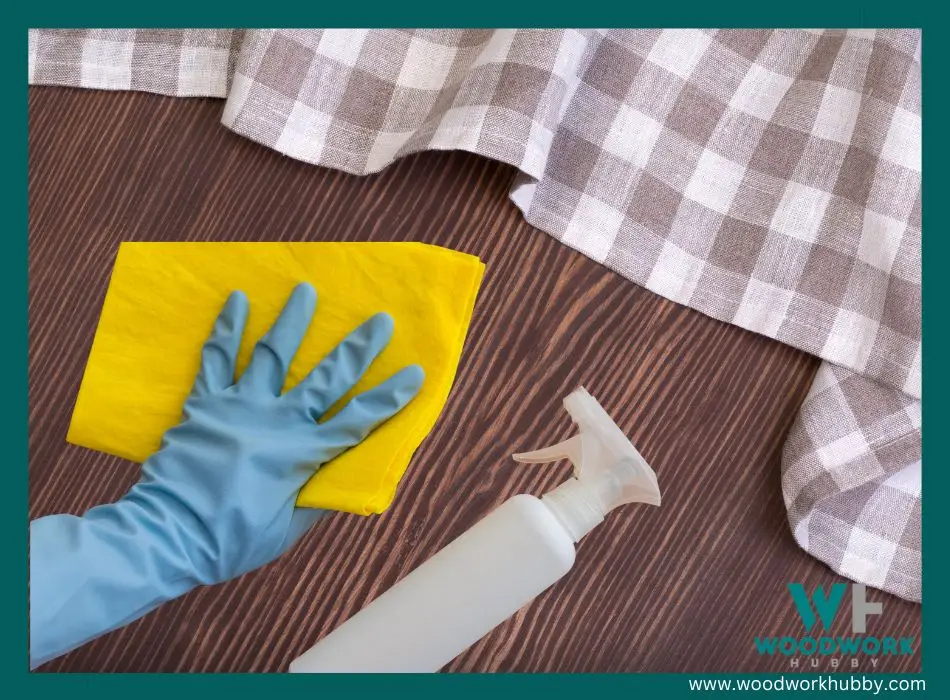
- First, get a clean cloth and put some rubbing alcohol on it.
- Gently rub the sticky residue on your table using the cloth.
- Repeat the process until all the sticker adhesive or tape residue is gone.
- Wipe your table clean with a dry cloth.
Applying nail polish remover
I get to use nail polish remover often when I need to clean sticky residue off my wood tables. It is known as a powerful solvent. Here are the steps to use this when cleaning:
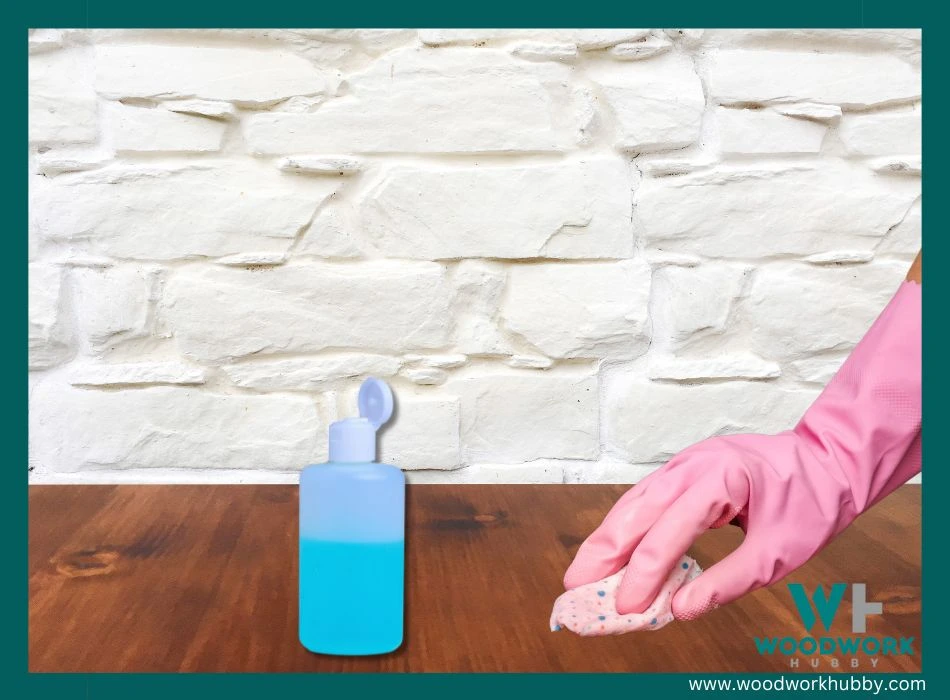
- Find a clean cloth and put some nail polish remover on it.
- Carefully dab spots of sticky residue with the cloth.
- Make sure to be slow with your process as too much remover can harm the wood.
- Leave the solution on for a few minutes before you wipe it off.
- Use another damp cloth to pick up leftover nail polish remover.
- Dry the spot once all of the sticky substance is gone.
Using a hairdryer and warm soapy water
I always turn to my hairdryer and some warm, soapy water when I face sticky residue on my wood table. It works wonders every time! Here’s how I do it:
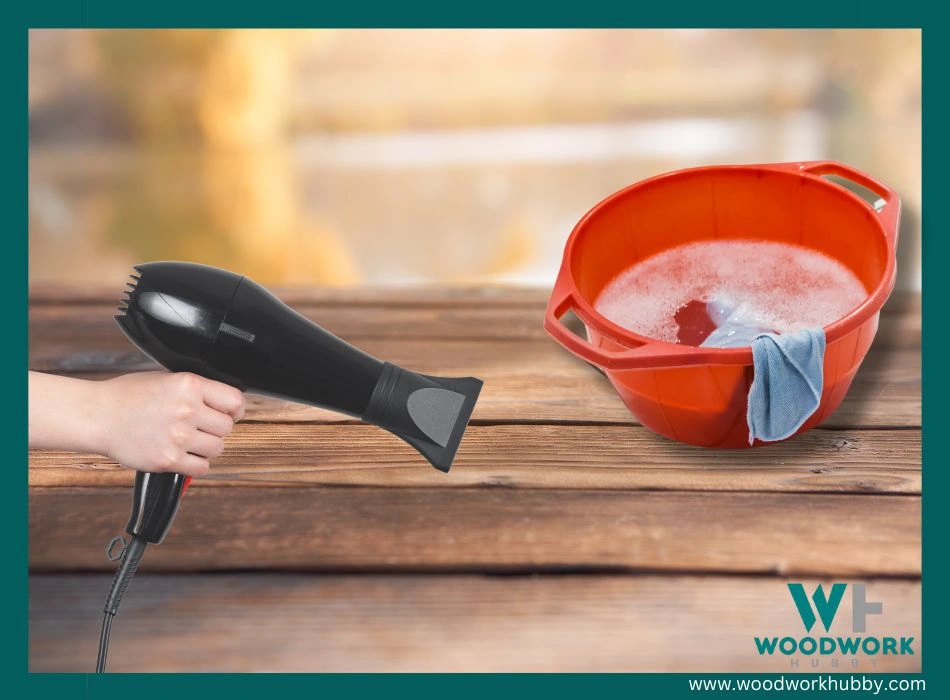
- First, I fill a bowl with warm water.
- Next, I add a squirt of dish detergent to the water and mix it all up.
- Then, I dip a clean rag into this soapy mix.
- After that, I place my hairdryer in its lowest warm setting.
- The next step is to aim the hairdryer at the sticky spot on the tabletop.
- The goal here is to soften the adhesive with heated air.
- While aiming for the hairdryer, I use my other hand to wipe at the softened adhesive with the soapy rag.
- I keep doing this until all of that sticky residue comes off.
Sanding the affected area
Sanding is one of the ways to clean a sticky top on your wood table. It is a process where you use sandpaper to rub off the gunk. Here are easy steps to do that:
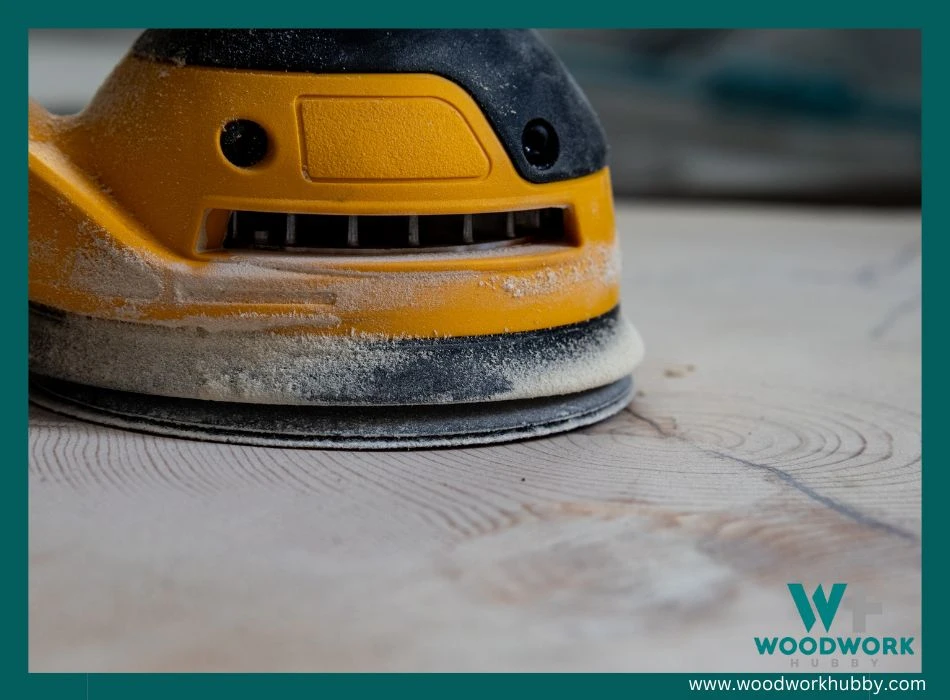
- I get fine-grit sandpaper. This kind won’t harm my table.
- Next, I take off loose bits from the table. I use a dry cloth to wipe well.
- Now, it’s time for sanding! I rub the part on my table with the sandpaper.
- I make sure not to rub too hard, so I don’t hurt my wood.
- After some time of rubbing, all the sticky stuff should be gone!
- Once done, I clean up any left dust.
Precautions and Tips for Removing Sticky Residue
When removing sticky residue from your wood table, always test the cleaning solution on a hidden area first. Use a gentle circular motion and avoid harsh scrubbing to prevent damaging the wood finish.
Consider applying furniture polish or wax after the process as this will serve as a protective layer for your wood surface. In severe cases of sticky residue, consulting a professional might be your safest bet!
Testing the cleaning solution on a small, inconspicuous area
Before using a cleaning mix on the whole table, I always do spot testing. An unnoticeable part of the wood is best for this safety step. If the solution harms this small test area or changes its color, it’s not safe to use everywhere.
So, spot testing helps in discoloration prevention and makes sure that our tabletop remains beautiful. With surface compatibility checked, we are ready to clean without worry!
Using gentle motions and avoiding harsh scrubbing
Be gentle with your wood table. Rough scrubbing can hurt it. Use light touches and easy moves to get sticky stuff off the surface. Microfiber cloths are great for this task. They clean well but don’t scratch or harm the wood.
You might feel like you need to push hard, but don’t! Heavy pressure may lead to scratches! Hard objects like steel wool should stay far away from your table too! Take care of your wooden furniture by using soft methods when getting rid of stubborn residue—this way, it stays safe and sound!
Protecting the wood with a layer of furniture polish or wax
Put on a thin layer of furniture polish or wax on your table. This may keep the wood safe. Do this two to four times a year, not more. Too much can make the surface sticky again.
Be careful with what you use. Some polishes might harm the wood finish. The wrong type of wax can be bad too! It could make dirt stick to your table and dull its looks. So always choose the right product for your table’s wood type!
Seeking professional assistance for severe cases
Don’t let a thick layer of sticky residue ruin your wooden table. Sometimes, homemade solutions aren’t enough. You need an expert hand. Indeed, seeking professional assistance for severe cases is a smart move.
These experts can put your worries to rest.
Professional help provides effective cleaning without harming the wood surface. They have the right skills and tools to clear away stubborn messes on your table top. What’s more, experts are skilled in restoring tables with serious damage due to long-term stickiness or rough handling while trying to clean it yourself.
Aftercare and Maintenance
To prevent future sticky residue buildup, make sure to wipe down the table regularly. The application of a protective finish or sealant aids in maintaining the pristine condition of your wood tables.
Ensuring proper care and maintenance extends not only the longevity but also enhances the overall appeal of your cherished furniture items.
Wiping down the table regularly to prevent future buildup
Regular cleaning is key for keeping a wood table top in good shape. Each day, I use a soft cloth to wipe it down. This removes loose debris and dust. It’s easy to keep the surface nice with gentle scrubbing only.
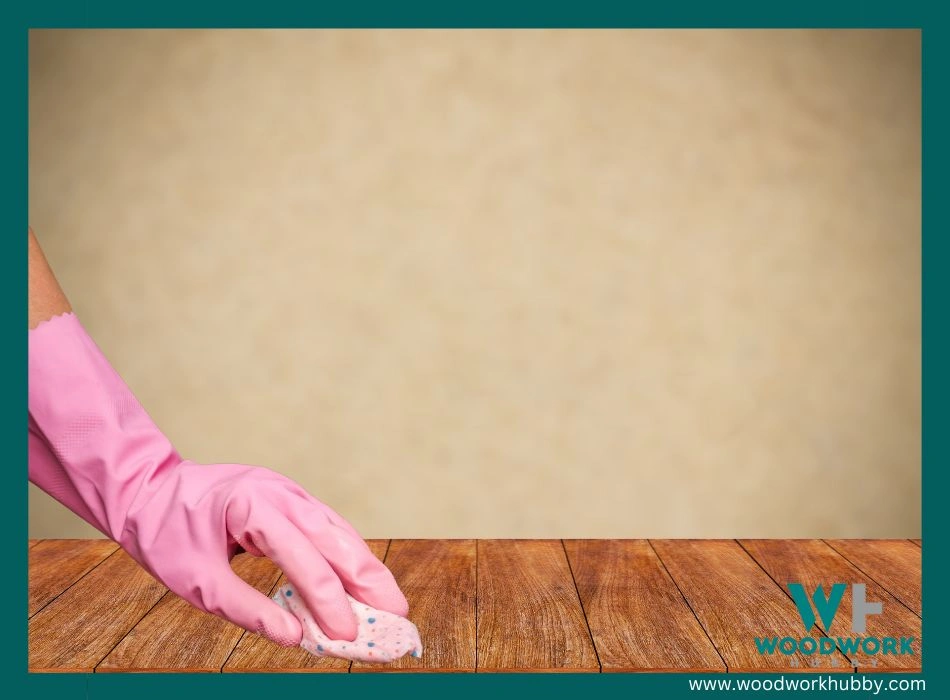
Too much force can make marks or streaks on the tabletop. If I see water stains or ink, I clean them right away too. This stops them from becoming stuck on residue later. Taking care of my table is as simple as doing these steps each day!
Applying a protective finish or sealant to maintain the table’s condition
To keep your table looking good, use a protective finish or sealant. This makes it harder for future sticky stuff to stay on the surface. You should also think about using cloth tablecloths and placemats.
They add color and style while keeping the table safe from stains, moisture, and heat damage. Coasters are helpful too! These prevent ring marks left by hot or cold drinks. For daily care, a fast wipe with a slightly damp cloth keeps dust away without hurting the wood finish.
From time to time applying a thin coat of wax perks up its look while giving more defense against harm.
Conclusion – How To Remove Sticky Residue From Wood Table Top
Fixing a sticky table top is not hard. You can use common items like vinegar, olive oil, and rubbing alcohol. Keep your wood tables clean to stop stickiness later. Don’t worry if you need help; ask for it!
FAQs
1. What can I use to remove sticky residue from my wood table top?
You can use mild soap and warm water or a mixture of vinegar and water to clean the sticky surface.
2. Can I scrape off the sticky stuff from my wood table?
Sticky stuff can be scraped off but be careful when using a plastic scraper or an old credit card so as not to scratch the table’s finish.
3. Will vinegar damage the finish on my wooden table if I use it to remove stickiness?
Vinegar will not harm your wood finish but do a small test spot first just in case!
4. How long should I leave the cleaner on before wiping it off?
For tough spots, let the cleaner sit for about 10 minutes before gently rubbing away the residue with a cloth or soft sponge.
5. Should my room have good ventilation while cleaning up the sticky mess?
Ensuring proper air circulation helps minimize lingering odors from strong cleaners during the cleaning process.




